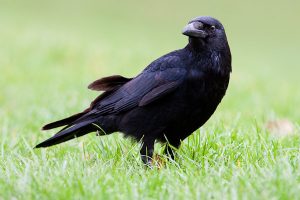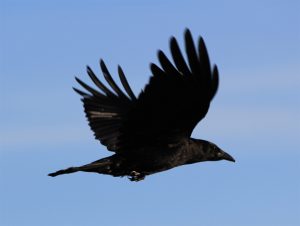Crows are a very familiar sight throughout the countryside and are part of the corvidae family which includes the raven, rook, jackdaw, jay and magpie.
Crows can often be seen in the top of a swaying tree or in the middle of fields; their habitats are as far ranging from town centres to seaside beaches.
They are very intelligent, large, powerful, black birds with a very distinctive cawing voice. This call being so familiar to many backgrounds that it is hardly ever noticed.
The crow family is considered to be one of the most highly developed of all the bird families and is said to correspond to the primates within mammals. Their intelligence far exceeding that of most other birds.
This intelligence and an awareness of humans make them difficult to approach. If they become aware of being watched they will often take to flight. It is said that crows can remember human faces and therefore will always avoid somebody they know to be antagonistic or a threat.

They will feed on almost anything including insects, earth worms, seeds, fruit and carrion.
Their flying is made up of a methodical powerful flapping that is occasionally broken up with glides and often results in them soaring to great heights.
Crows are mostly found alone or in pairs – the pairing being for life.
Crows have been known to make and use tools. They have been seen using twigs to force out grubs within fence posts or trees and even dropping nuts in trafficked areas waiting for vehicles to crack them open.
Splendid myths and stories abound around the crow from many countries over the centuries – such as the keeping of ravens at the tower of London for protection over the fortunes of Britain, to the three legged crow in Chinese and Japanese mythology representing the sun or divine intervention.
